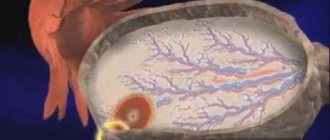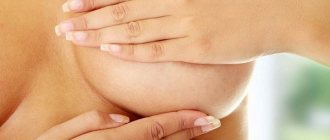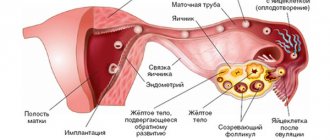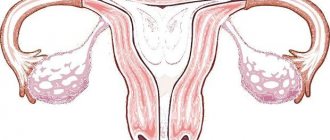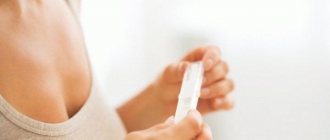A woman experiences various pain sensations every month, indicating certain processes that characterize a given period of time. For example, lower back pain occurs during monthly bleeding, minor nagging pain in the abdomen and swollen and sore breasts after ovulation. Such signs confirm the very fact of ovulation, when the egg breaks through the follicle.
Breast pain after ovulation
If your breasts hurt after ovulation, this is a natural sign of egg maturation. Discomfort can manifest itself in varying degrees of intensity. Some female representatives feel only a slight increase in breast sensitivity, while for others it hurts so much that they literally suffer from unbearable pain .
The symptoms of the process of egg maturation depend on the woman’s lifestyle, her state of health, as well as a number of individual characteristics of her body. If after ovulation your breasts stop hurting within a few days, then there is no reason to panic. But if the pain persists for more than 2 days , then this is a reason to consult a doctor.
Character
The nature of pain in the mammary glands after ovulation can be different. If the same sensations occur from month to month, and the doctor has not identified any abnormalities in the functioning of the internal systems, then there is no reason to worry.
This condition is only an individual feature of a woman, even if the discomfort causes significant inconvenience and changes the quality of life.
The nature of pain can be manifested by the following conditions:
- increased sensitivity of the nipples and mammary glands (pain occurs during palpation);
- swelling (breast glands increase in size);
- aching or nagging pain (the intensity increases during physical activity or when walking);
- tingling in the chest area (short-term attacks).
REFERENCE! In some women, chest pain after the ovulatory process reaches such intensity that it makes it difficult to move and perform normal physical activities. Moreover, even such a condition can be the norm, and the main reason for its appearance is the individual characteristics of the body.
How many days after ovulation do your breasts hurt?
The norm is to maintain sensitivity of the mammary glands for two days after ovulation. In some females, such symptoms appear only for a few hours. When assessing the condition, it is important to take into account previous ovulatory processes and, if necessary, consult a specialist.
Types of mastalgia
Medicine knows several types of breast tenderness, not all of which are directly related to ovulation.
Cyclic
Pain associated with ovulation is called cyclical, since it tends to recur in subsequent cycles, and is also always associated with changes and fluctuations in hormonal levels. Cyclic mastalgia is considered physiological and usually does not require treatment.
With cyclical changes, the nipples usually hurt, and nagging pain may appear on the sides of the mammary glands. The pain is aching in nature, usually both glands look swollen and enlarged symmetrically.
Acyclic
Acyclic mastalgia usually manifests as unilateral pain and discomfort in only one breast. But such a condition can also be natural if it is an individual feature. Often, after ovulation, only one mammary gland is bothered. The appearance of acyclic mastalgia, if it was not previously characteristic of a woman, may indicate that hormonal contraception has recently been taken; very often this occurs after taking Postinor and other means of emergency postcoital contraception.
Why do my breasts hurt after ovulation?
Increased sensitivity of the breast and the occurrence of pain of various types is a natural reaction of the body to the process of egg maturation.
Causes of pain:
- increased levels of the hormone progesterone (breast tissue is very sensitive to this hormone);
- the glands are preparing for potential lactation (in the event of fertilization of the egg);
- with breast enlargement, compression of the nerve endings , which can cause discomfort;
- during the ovulatory process in a woman’s body, the amount of fluid increases, which accumulates in the mammary glands (the tissues increase in size, and this process is accompanied by an increase in their sensitivity);
- insufficient decrease in estrogen levels in the second phase of the cycle (if the decrease occurs in accordance with the norm, then the pain is insignificant, if the process is carried out at a slow pace, then the pain will occur with greater intensity).
The reproductive system is in close relationship with the mammary glands. During ovulation, the reproductive organs begin to prepare for potential conception , and the breasts begin to instantly respond to the changes occurring. This is why the mammary glands hurt immediately after ovulation.
Etiology of the female cycle
A woman's fertility is determined by the menstrual cycle. Hormonal levels are involved in its construction.
The first stage begins with an increase in estrogen in the blood. Estrogen is the main female hormone responsible for the appearance of secondary sexual characteristics. Its growth is accompanied by additional processes in the body. An additional layer begins to appear in the uterine body. Endometrial tissue facilitates the implantation of a fertilized egg into the uterine wall. Also, with estrogen, the appearance of a follicle-stimulating substance is observed. It is responsible for preparing the body for ovulation.
Under the influence of FSH, a subtle complex process begins in the body. A follicle forms on the ovary. This neoplasm is a kind of storage for the female egg. She is gradually preparing to leave. In this case, the wall of the follicular sac stretches, becomes thin and brittle. At the end of the preparatory stage, estrogen decreases.
Microscopic examination of blood in the body reveals luteinizing hormone. It is responsible for changing the composition of follicular fluid. The fluid increases in volume, the diameter of the follicular sac increases. The walls cannot withstand the pressure and burst. From the ruptured follicle, the egg penetrates into the abdominal cavity. This period is the initial stage of ovulation. Ovulation itself is characterized by the passage of the egg into the inner part of the fallopian tubes. It is during this time period that a long-awaited pregnancy can occur.
After ovulation, a woman enters the progesterone phase. During this period, the body is controlled by progesterone. The main part of the substance is located in the cavity of the corpus luteum. It takes the place of a burst follicular sac. Progesterone is excreted from the body in small doses. If fertilization is successful, the corpus luteum functions throughout the first trimester. Once the body stops functioning, progesterone recedes.
It is in the second phase that many planning girls begin to look for the first signs of pregnancy.
What to do to relieve pain?
Chest pain after ovulation goes away on its own. There is no need to take special measures to treat this condition. However, if the discomfort causes significant inconvenience and interferes with the quality of life , then you can use some recommendations to reduce pain. In this case, it is important to distinguish the normal condition from the symptoms of serious diseases associated with the mammary glands.
ON A NOTE! The intensity of ovulation signs is largely influenced by a woman’s lifestyle.
alleviate the condition in the following ways:
- of fluid consumed a few days before it begins ;
- baths with the addition of medicinal herbs (any herbal infusion can be used, but baths with calendula, chamomile or St. John's wort are especially recommended);
- massage with ice cubes wrapped in a bandage or gauze (the procedure can be performed once a day);
- reducing the amount of salt consumed (salt makes it difficult to remove fluid from the body, and when the egg matures, its amount increases);
- Supportive underwear will help secure the mammary glands and reduce their sensitivity;
- breast massage with essential oils (movements should be as smooth as possible);
- You can eliminate unpleasant sensations with conventional painkillers (chest pain in the postovulatory period is accompanied by similar manifestations in the lower abdomen, so No-shpa, Ketarol or other painkillers will help improve your general condition).
You also need to diversify your diet with vitamins and healthy foods, as well as take a course of vitamin complexes. Such actions will ease the symptoms of subsequent egg maturation.
How to reduce discomfort at home
When breasts hurt after ovulation, in most cases this is considered normal for a woman. Taking painkillers is indicated only in severe cases, when discomfort does not allow you to lead a normal lifestyle. This is because medications can have side effects. In addition, with frequent use, they become addictive and become useless.
When your breasts hurt after ovulation, a warm, relaxing shower will help improve your condition. It is undesirable to take a hot bath, as it can have a negative effect on the organs of the reproductive system. It is permissible to perform a light massage using essential oil. Smooth circular massage movements should be directed towards the nipple.
In the post-ovulation period, you should protect yourself from stressful situations and avoid nervous tension. Vitamin complexes that contain vitamins A, E and group B are effective.
When to see a doctor
There are signs that require special attention. Reasons for visiting a doctor may include:
- The presence of one or more compactions that are independently detected upon palpation.
- Long duration of pain.
- Painful sensations cannot be eliminated by any method of pain reduction.
- Increase in body temperature.
- Formation of suspicious rashes, change in breast color.
If your chest hurts in the second half of the cycle, accompanied by other signs of disease, you should consult a doctor as soon as possible. Only a doctor will be able to determine the exact cause of pain in the mammary glands and, if necessary, prescribe proper treatment.
